- Bernard Preston homepage
- Breakfast
- Nutritious Green Smoothie
Nutritious green smoothie
This nutritious green smoothie is particularly good for those suffering from insulin resistance; but not if you use commercial honey or non-nutritive sweeteners.
It is low in sugars and the avocado supplies the good fats that give satiety to your meal; you will not be famished at 11 o'clock. Reaching for a candy-bar or a cola is a sure sign you have not had an adequate breakfast.
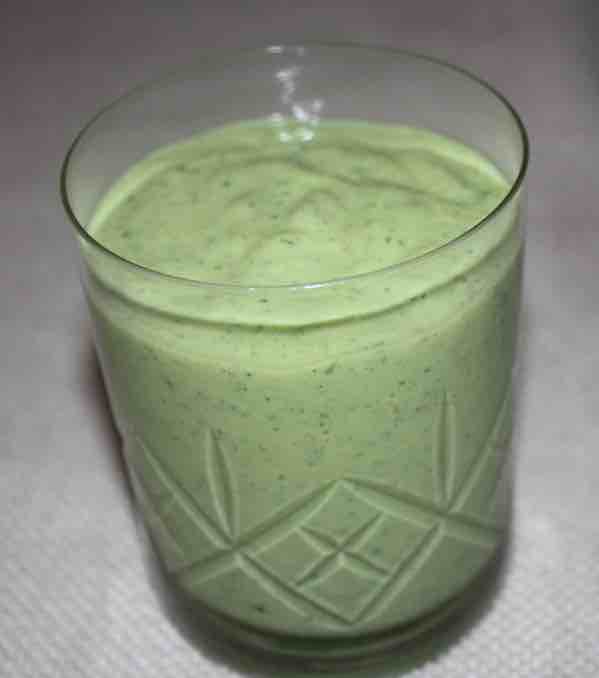
Ingredients for two glasses
- A handful of young dark-green veggies like spinach and kale.
- 1 cup of kefir or coconut-milk. I add half of each.
- 1/2 tsp natural-honey.
- 1/2 avocado.
- 1/4 banana.
- A few drops of lime or lemon-juice to give your smoothie a little pungency.
- A tablespoon of freshly-ground flax and other seeds.
- Wash the greens thoroughly checking for snails and frogs.
- Drop all the ingredients into a tall container and whizz them with a stick-blender.
- What could be easier?
- Oats milk is another option.
Dark-green leafy vegetables
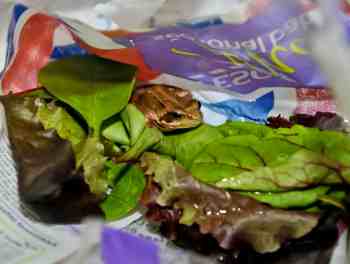
There is heaps of strong scientific evidence that we should all be consuming far more dark-green leafy vegetables. For the lutein alone, I enjoy them; those who refuse to eat Popeye Food are highly likely to get macular degeneration and cataracts, particularly if they smoke.
They also cured me once and for all of a very stubborn and lazy colon; now a BM is an easy two-minute affair.
Another of these essential phytonutrients in your greens is kaempferol; it has many benefits including the prevention of malignant-tumours.
It is a great concern of mine that doctors in general place so much stress on screenings, knowing we are going to get these diseases; would a declaration of the heaps of evidence on how to prevent them not be more sensible?
It seems that the slogan "prevention is better than a cure" has been long forgotten; or trotted out and then completely ignored.
Did you spot the frog? Incidentally I'm not shocked or anxious when I find creepie-crawlies in the ingredients I am preparing; they are the proof that food has not been sprayed with toxic poisons. I am far more neurotic about the things I am unable to see.
The corner of a leaf of spinach that has been chewed by a locust does not bother me in the slightest; it is like the king's taster.
Kefir
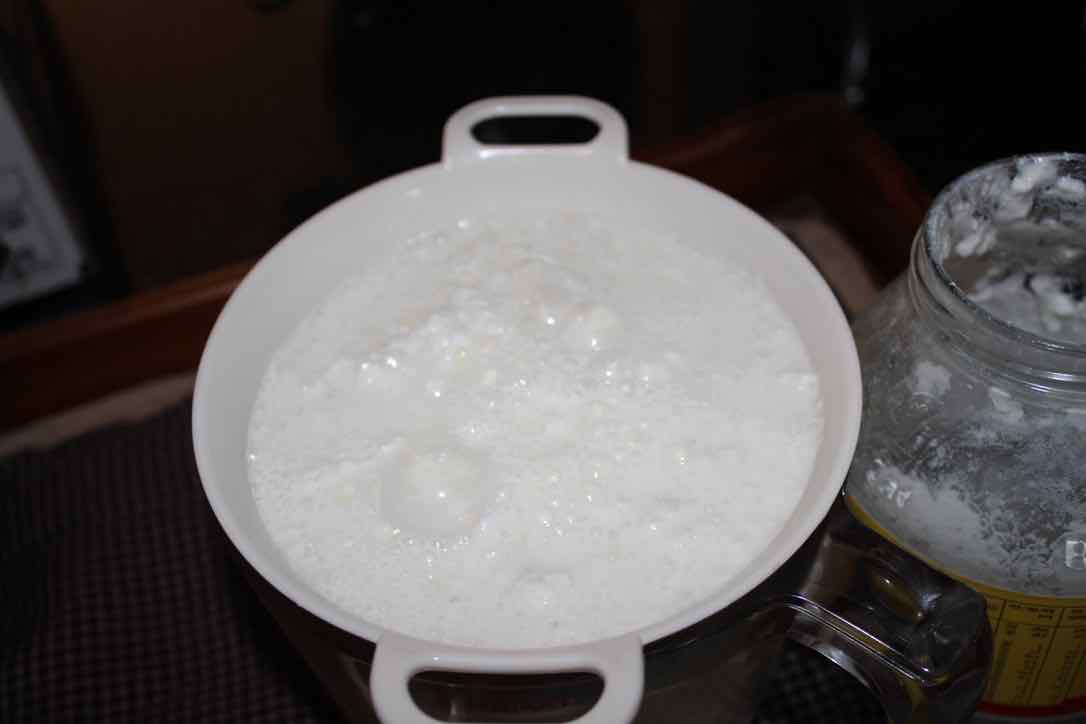
There is so much research coming out now on the importance of a broad spectrum of bugs in the intestine; it's known as the normal-flora, or microbiome if you want to be fancy.
You can take expensive probiotic supplements that will almost certainly provide no more than 4 to 6 different friendly bacteria, or make your own kefir which has over 30. It needs about five-minutes and having acquired the starter, the only cost is that of a cup of milk.
It is incidentally also the proven best natural source of absorbable calcium.
Natural honey is quite difficult to find; you will have to locate a local beekeeper most likely. Much of the stuff on supermarket shelves today is adulterated with high-fructose corn syrup and has been heated, raising the GI alarmingly.
Rich in local pollen, unheated natural honey has a surprisingly low glycemic load; it will not give you a blood-sugar surge but do stick to half a teaspoon. It will help with any hayfever too.
Even as a beekeeper, I restrict myself to about three teaspoons per day. It is after all a simple carbohydrate; that sweet-tooth needs to be pulled.
Saturated fat in our food remains controversial but increasingly the evidence is fingering the refined carbs as the source of our obesity; the colas, bagels and energy-bars. And that those from sunflower and soybeans, in excess are highly inflammatory.
There is overall agreement amongst scientists however that the fruit-fats from the avocado and olive are supremely good for us; we don't need to hold back.
Bananas
Bananas too get bad press for various reasons. But they do have a moderate glycemic index of 62, depending on how ripe they are; they do have rather more starch than other fruit such as apples and pears.
Having said that most of us eat far too much carbohydrate. I recommend no more than 150 grams per day and much less if you are obese or prediabetic; that's nearly 50% of the population on typical grocery store food.
So our nutritious green smoothie gets only 1/4 banana per person. That will then seriously reduce the glycemic load; but it's still about 30g of starch.
Smoothies must have banana; perhaps not.
In general researchers are not convinced that bananas are "the worst of fruits you can eat." They are rich in important minerals like magnesium and potassium; vitamins and fibre also. Just don't have too much especially if there are other carbs in the meal; limit the overall glycemic load.
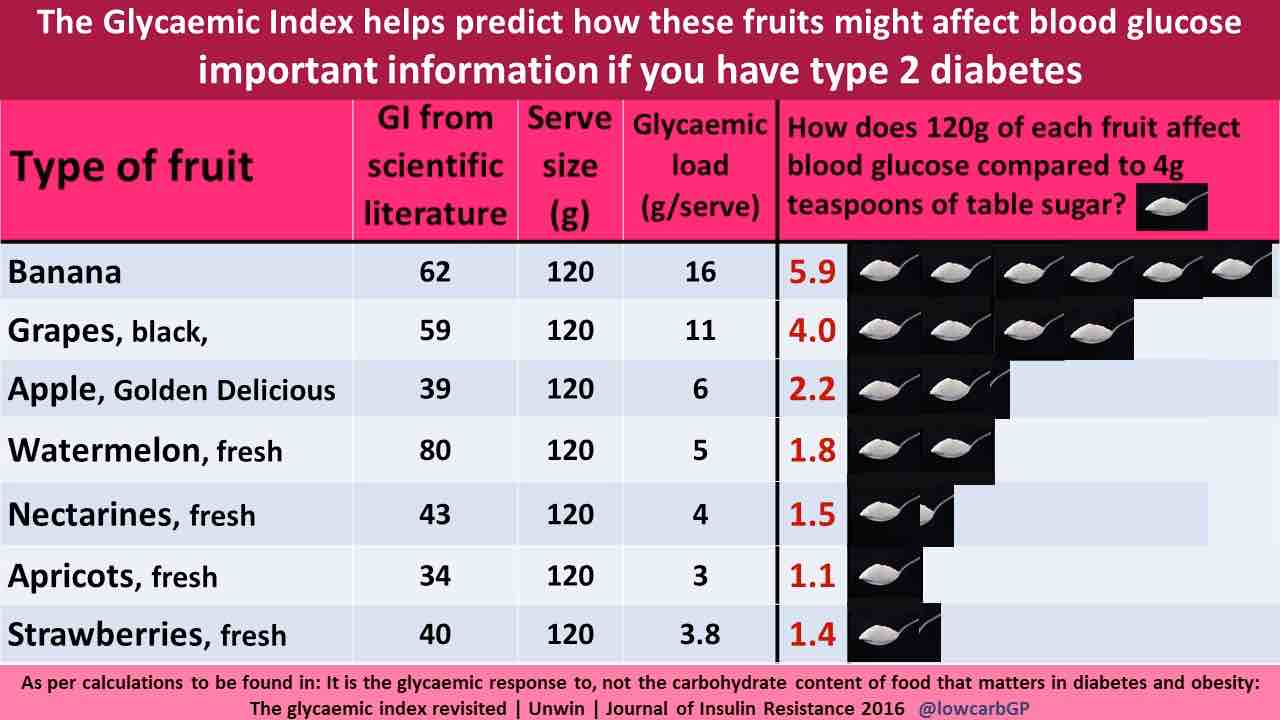
There are moves away from the traditional EG method of measuring starch content in fruit.
The modified mEG gives quite different values; thus you may be confused by wildly contradictory numbers[3].
Flaxseed
Flaxseed is dynamite stuff; rich in fibre, omega-3 fatty acids and lignans[1] but you must grind it yourself. It is a powerful antioxidant and spoils very quickly once the shell has been cracked.
Grinding flaxseed is a cinch. All you need is one of those inexpensive blenders for your herbs and spices. If you get a touch of cumin in your nutritious green smoothie it will only add to the richness and flavour.
Never eat whole flax or sesame-seed by the way; they are not digested and may get stuck in diverticuli. Every home should have one of these blenders.
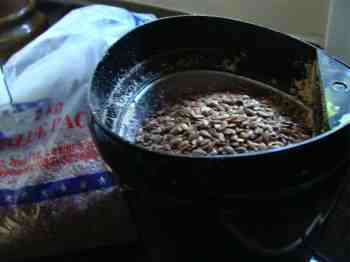
Natural honey
Honey is one of the most adulterated foods in the world. Unscrupulous companies incorporate high-fructose corn syrup which is dreadful stuff.
Think about keeping a few hives in your garden; then you must start looking out for swarming bees.
The only other way to be sure of natural honey is to find a small local beekeeper who can assure you he doesn't mess with it. If at all possible try and get it yourself straight from the bottling-tank.
Is it time to pull the sweet tooth?
Sweetness is highly addictive in humans. If sugar is out and much of commercial honey is adulterated with high fructose corn syrup, then folk feel the need to use non-nutritive sweeteners; despite the convincing research that Splenda for example damages our DNA and the lining of the gut[4].
Is it just time to pull that sweet tooth altogether?
Choline
Choline is one of the many B-vitamins that are so important; the average person is eating less than half the required amount. Green leafy vegetables are a great source. Think about adding half a dozen chickpeas to your smoothies to make them better still.
That will provide satiety, the sense of fullness so you will not be feeling the need to reach for a cola or candy bar at 11 o'clock.
These are the choline food sources. It really is astonishing that we are not getting enough according to levels measured in the blood.
Nutritious green smoothie
This nutritious green smoothie can be made in a jiffy; absolutely avoid the various sharks trying to palm their powders off on you.
Real food doesn't need these additives. Your smoothie is already a powerhouse of fibre, resistant-starch and protein; not to mention the nutritious fats and phytochemicals. It is dynamite.
Honestly it supplies such satiety that it really is a complete meal in itself if you are seriously trying to shed pounds; it could be your whole breakfast. This weight loss research will blow your mind; it explains why dieting is totally futile.
If you are on one of the ketogenic food-plans then simply drop the banana completely until you've got the pounds off.
Berries
It is interesting that the various ketogenic diets are against all carbs but allow and actually encourage berries.
By all means drop a strawberry[2] for example into your nutritious green smoothie; they are loaded with phytonutrients that even help prevent adult-onset blindness.
Growing milky oats
Growing milky oats is something to experiment with if you are a gardener; the extract from the young grain, plucked before it ripens is reputed to be particularly rich in vitality. It may go well in your nutritious green smoothie.
When browsing use right click and Open Link in New Tab, or you may get a bad gateway signal.
Newsletter
Our newsletter is entitled "create a cyan zone" at your home, preserving both yourself and Mother Earth for future generations; and the family too, of course. We promise not to spam you with daily emails promoting various products. You may get an occasional nudge to buy one of my books.
Here are the back issues.
- Lifestyle and ideal body weight
- What are ultra-processed foods?
- Investing in long-term health
- Diseases from plastic exposure
- Intensive lifestyle management for obesity has limited value
- A world largely devoid of Parkinson's Disease
- The impact of friendly bacteria in the tum on the prevention of cancer
- There's a hole in the bucket
- Everyone is talking about weight loss drugs
- Pull the sweet tooth
- If you suffer from heartburn plant a susu
- Refined maize meal and stunting
- Should agriculture and industry get priority for water and electricity?
- Nature is calling
- Mill your own flour
- Bake your own sourdough bread
- Microplastics from our water
- Alternative types of water storage
- Wear your clothes out
- Comfort foods
- Create a bee-friendly environment
- Go to bed slightly hungry
- Keep bees
- Blue zone folk are religious
- Reduce plastic waste
- Family is important
- What can go in compost?
- Grow broad beans for longevity
- Harvest and store sunshine
- Blue zone exercise
- Harvest and store your rainwater
- Create a cyan zone at your home
Did you find this page interesting? How about forwarding it to a friendly book or food junkie? Better still, a social media tick would help.
- Bernard Preston homepage
- Breakfast
- Nutritious Green Smoothie
Address:
56 Groenekloof Rd,
Hilton, KZN
South Africa
Website:
https://www.bernard-preston.com